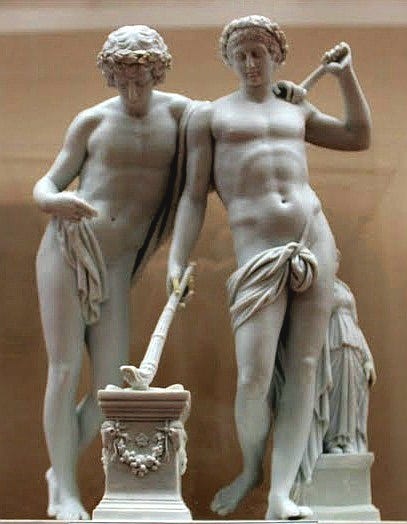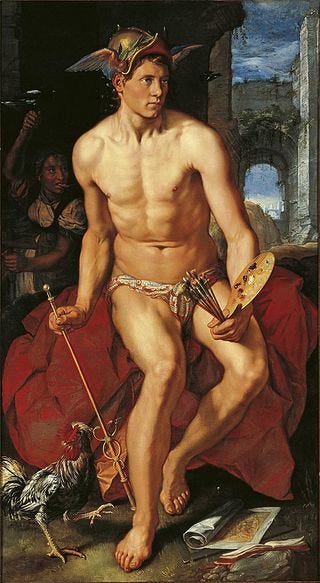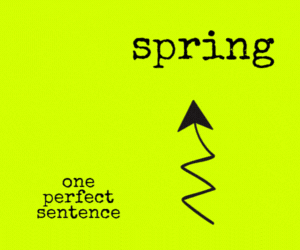- Feb 3, 2024
- LitBits
- 0
New blog post by Katie-Ellen Hazeldine
The Zodiac for Writers: Introducing Gemini
This year the sun is in the sign of Gemini from May 20- June 21, 2025. The dates for the zodiac sun signs can vary by a day or two from year to year for astronomical reasons. Gemini, the third sign of the Western Tropical Zodiac, is a mutable Air sign representing a borderline season in Nature; the end of spring and beginning of summer in the northern hemisphere.
To see the constellation of Gemini with the naked eye, we need to look north east of the constellation Orion between the Taurus and Cancer constellations. Gemini is the northernmost constellation in the zodiac, and the thirtieth largest in size, visible high in the winter sky in the northern hemisphere, looking north east of Orion between Taurus and Cancer. February is the best time to view Gemini. By April and May, we get the best views looking west soon after sunset. The two brightest stars in the constellation are the “twins” themselves – Castor and Pollux, representing the heads of the twins,
Gemini, from the Latin word meaning “twins,” is the first sign of the western tropical zodiac year that has a human representation rather than an animal one, following Aries the Ram and Taurus the Bull. Gemini represents the key principle of duality or polarity, similarities and opposites, life and death, light and dark, night and day, hot and cold.
We see this principle in active operation in late spring, in the climax of splitting or cloning. Pollen flies free. Eggs hatch. Butterflies and dragonflies hatch out of their chrysalis. The agility of airy Gemini is literally in our faces right now, in the gardens, woodlands, fields and hedgerows in the northern hemisphere. Mid-May is the start of grass pollen season, building to a peak in mid-July:-
“May is quite the roller-coaster when it comes to tracking pollen. Dock and lime pollen start triggering hay fever in May as they begin their season, while both pine and oil seed rape peak and end within the month. Oak and plane end their peak – but grass pollen begins hitting its high notes.”

The world mythology of twins goes back at least as far as the so-called “Age of Gemini”, during the Palaeolithic, 6, 500 BC/BCEE, arising from our understanding of the duality fundamental to the nature of reality. There are countless stories of the twins in world myth, representing dualities and polarities; night and day, light and dark, heat and cold, male and female, war and peace, good and bad, life and death. The creation myths of ancient cultures across the world reflect this eternal battle of seeming opposites. In some cultures, twins, especially identical twins, have been feared on account of this very duality.
Classical Greek mythology personified the idea of the twins as the twin brothers, Castor and Pollux, aka The Gemini. The name “Castor comes from the Greek Καστωρ (Kastor) and means “to excel, to shine.” Pollux comes from the Roman form of Greek Πολυδευκης (Polydeukes) and means “very sweet.” The circumstances of their birth were unusual, to say the least. Queen Leda of Sparta was bathing in the river when Zeus, disguised as a swan, gliding about, pretending to peck at things, suddenly pounced on her and did the business. That night, notwithstanding this trauma, or perhaps because of it, Leda also slept with her husband King Tyndareus and went on to produce four children; Castor, Pollux and their sisters Helen (later Helen of Troy) and Clytemnestra (later married to Agamemnon as queen of Mycenae.) Pollux and Helen, fathered by Zeus, were immortal, while Castor and Clytemnestra, fathered by Tyndareus, were mortal.

Source: Public Domain, the young Castor and Pollux (Meissen)
The mortal Castor was a renowned horseman and a master at fencing, while the immortal Pollux was known for his great strength and skill at boxing. But then Castor was killed, possibly in a quarrel over dividing the spoils after a cattle raid. Pollux was distraught. He didn’t want immortality. Not if it meant being without his brother. He begged Zeus to make him mortal, and then kill him so he could be with his brother. Zeus couldn’t bring himself to do that, scratching his head, wondering how to fix this, and decided to place them both in the stars, to be together forever as the constellation of Gemini.

Mercury by Hendrick Goltzius, 1611, Public Domain
The planetary ruler of Gemini is Mercury, the planet nearest the Sun, representing the winged god Mercury or Hermes; patron deity of all forms of communication, media, trade, global commerce and travel, medicine, research and analytics. Also siblings and neighbours. And now, alongside Uranus, Mercury denotes Information Technology.
Mercury as Hermes has a lesser known role as a psychopomp; one who can go between the realms of the living and the dead, a go-between and safe escort to the dead. It was Hermes who escorted the souls of the newly dead to the banks of the Acheron or The Styx, where they waited for Charon to ferry them across to the Underworld. Gemini is considered the most changeable and agile of the all the sun signs, inquiring, analytical, logical and restless.
Gemini stories feature Lovers, twins, siblings, dualities, polarities, rivalries, neighbours, divided loyalties, orators, intelligence, spies, scouts, double agents. Gemini is the most changeable and agile of the all the sun signs; inquiring, analytical, logical and restless. The Gemini character is friendly yet watchful, generous but changeable, sociable, and yet elusive -full of contradictions. In medical astrology, Gemini rules the arms and hands and lungs. The typical Gemini native is of above average personal appearance; personable, attractive, usually slim, and of average height or taller, and with neat, tidy facial features. Gemini is a natural born public speaker, with the gift of the gab.
And Gemini usually has plenty to say.
May the winged god Mercury inspire your writing this Gemini season.
Till next time.
---
The Zodiac for Writers: Introducing Gemini
This year the sun is in the sign of Gemini from May 20- June 21, 2025. The dates for the zodiac sun signs can vary by a day or two from year to year for astronomical reasons. Gemini, the third sign of the Western Tropical Zodiac, is a mutable Air sign representing a borderline season in Nature; the end of spring and beginning of summer in the northern hemisphere.
Astronomy
To see the constellation of Gemini with the naked eye, we need to look north east of the constellation Orion between the Taurus and Cancer constellations. Gemini is the northernmost constellation in the zodiac, and the thirtieth largest in size, visible high in the winter sky in the northern hemisphere, looking north east of Orion between Taurus and Cancer. February is the best time to view Gemini. By April and May, we get the best views looking west soon after sunset. The two brightest stars in the constellation are the “twins” themselves – Castor and Pollux, representing the heads of the twins,
Natural History
Gemini, from the Latin word meaning “twins,” is the first sign of the western tropical zodiac year that has a human representation rather than an animal one, following Aries the Ram and Taurus the Bull. Gemini represents the key principle of duality or polarity, similarities and opposites, life and death, light and dark, night and day, hot and cold.
We see this principle in active operation in late spring, in the climax of splitting or cloning. Pollen flies free. Eggs hatch. Butterflies and dragonflies hatch out of their chrysalis. The agility of airy Gemini is literally in our faces right now, in the gardens, woodlands, fields and hedgerows in the northern hemisphere. Mid-May is the start of grass pollen season, building to a peak in mid-July:-
“May is quite the roller-coaster when it comes to tracking pollen. Dock and lime pollen start triggering hay fever in May as they begin their season, while both pine and oil seed rape peak and end within the month. Oak and plane end their peak – but grass pollen begins hitting its high notes.”

History and Mythology
The world mythology of twins goes back at least as far as the so-called “Age of Gemini”, during the Palaeolithic, 6, 500 BC/BCEE, arising from our understanding of the duality fundamental to the nature of reality. There are countless stories of the twins in world myth, representing dualities and polarities; night and day, light and dark, heat and cold, male and female, war and peace, good and bad, life and death. The creation myths of ancient cultures across the world reflect this eternal battle of seeming opposites. In some cultures, twins, especially identical twins, have been feared on account of this very duality.
Classical Greek mythology personified the idea of the twins as the twin brothers, Castor and Pollux, aka The Gemini. The name “Castor comes from the Greek Καστωρ (Kastor) and means “to excel, to shine.” Pollux comes from the Roman form of Greek Πολυδευκης (Polydeukes) and means “very sweet.” The circumstances of their birth were unusual, to say the least. Queen Leda of Sparta was bathing in the river when Zeus, disguised as a swan, gliding about, pretending to peck at things, suddenly pounced on her and did the business. That night, notwithstanding this trauma, or perhaps because of it, Leda also slept with her husband King Tyndareus and went on to produce four children; Castor, Pollux and their sisters Helen (later Helen of Troy) and Clytemnestra (later married to Agamemnon as queen of Mycenae.) Pollux and Helen, fathered by Zeus, were immortal, while Castor and Clytemnestra, fathered by Tyndareus, were mortal.

Source: Public Domain, the young Castor and Pollux (Meissen)
The mortal Castor was a renowned horseman and a master at fencing, while the immortal Pollux was known for his great strength and skill at boxing. But then Castor was killed, possibly in a quarrel over dividing the spoils after a cattle raid. Pollux was distraught. He didn’t want immortality. Not if it meant being without his brother. He begged Zeus to make him mortal, and then kill him so he could be with his brother. Zeus couldn’t bring himself to do that, scratching his head, wondering how to fix this, and decided to place them both in the stars, to be together forever as the constellation of Gemini.
The Story Themes of Gemini

Mercury by Hendrick Goltzius, 1611, Public Domain
The planetary ruler of Gemini is Mercury, the planet nearest the Sun, representing the winged god Mercury or Hermes; patron deity of all forms of communication, media, trade, global commerce and travel, medicine, research and analytics. Also siblings and neighbours. And now, alongside Uranus, Mercury denotes Information Technology.
Mercury as Hermes has a lesser known role as a psychopomp; one who can go between the realms of the living and the dead, a go-between and safe escort to the dead. It was Hermes who escorted the souls of the newly dead to the banks of the Acheron or The Styx, where they waited for Charon to ferry them across to the Underworld. Gemini is considered the most changeable and agile of the all the sun signs, inquiring, analytical, logical and restless.
Gemini stories feature Lovers, twins, siblings, dualities, polarities, rivalries, neighbours, divided loyalties, orators, intelligence, spies, scouts, double agents. Gemini is the most changeable and agile of the all the sun signs; inquiring, analytical, logical and restless. The Gemini character is friendly yet watchful, generous but changeable, sociable, and yet elusive -full of contradictions. In medical astrology, Gemini rules the arms and hands and lungs. The typical Gemini native is of above average personal appearance; personable, attractive, usually slim, and of average height or taller, and with neat, tidy facial features. Gemini is a natural born public speaker, with the gift of the gab.
And Gemini usually has plenty to say.
May the winged god Mercury inspire your writing this Gemini season.
Till next time.
---
* Like this post? Please share here
* Start your own blog here

